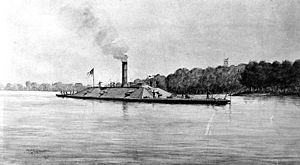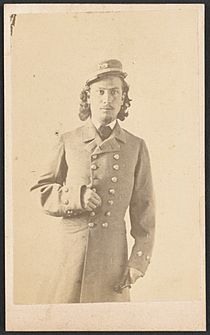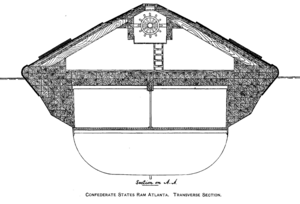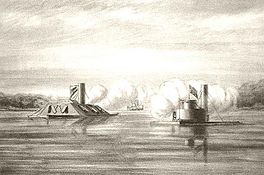USS Atlanta (1861) facts for kids

A sepia wash drawing of CSS Atlanta by R.G. Skerrett
|
|
Quick facts for kids History |
|
|---|---|
| Name | Fingal |
| Namesake | Fingal |
| Owner | Hutcheson's West Highland Service |
| Builder | J&G Thomson's Clyde Bank Iron Shipyard, Govan, Glasgow |
| Launched | 9 May 1861 |
| Fate | Sold, September 1861 |
| General characteristics | |
| Tonnage | About 700 tons (bm) |
| Length | 189 ft (57.6 m) |
| Beam | 25 ft (7.6 m) |
| Draft | 12 ft (3.7 m) |
| Depth of hold | 15 ft (4.6 m) |
| Installed power | 1 Tubular boiler |
| Propulsion |
|
| Speed | 13 knots (24 km/h; 15 mph) |
| Name | CSS/USS Atlanta |
| Namesake | Atlanta |
| Builder | Asa and Nelson Tift, Savannah, Georgia |
| Acquired | September 1861 |
| Commissioned | 22 November 1862 |
| Decommissioned | 21 June 1865 |
| Captured | 17 June 1863, transferred to US Navy in February 1864 |
| Fate | Sold to Haiti, 4 May 1869. Lost at sea, December 1869 |
| General characteristics | |
| Type | Casemate ironclad |
| Displacement | 1,006 long tons (1,022 t) |
| Length | 204 ft (62.2 m) |
| Beam | 41 ft (12.5 m) |
| Draft | 15 ft 9 in (4.8 m) |
| Depth of hold | 17 ft (5.2 m) |
| Speed | 7–10 knots (13–19 km/h; 8.1–11.5 mph) |
| Complement | 145 officers and men |
| Armament |
|
| Armor |
|
The CSS Atlanta was a special kind of warship called a casemate ironclad. She served in both the Confederate and Union Navies during the American Civil War. Originally, she was a British-built ship named Fingal that helped sneak supplies past blockades. The Confederacy turned her into an ironclad after she made one trip to Savannah, Georgia.
After a few tries to attack Union ships, Atlanta was captured in 1863 by two Union monitor warships when she got stuck. The Union Navy fixed her up, gave her new weapons, and used her for the rest of the war. She spent most of her time on the James River, helping Union forces. In 1865, she was taken out of service. Years later, Atlanta was sold to Haiti, but she was lost at sea in December 1869 while on her way there.
Contents
From Merchant Ship to Warship: The Story of Fingal
Fingal started as a merchant ship, built in Scotland in 1861. She was made of iron and measured about 189 feet (57.6 m) long and 25 feet (7.6 m) wide. She used two steam engines to move at about 13 knots (24 km/h; 15 mph).
The ship briefly worked in Scotland. Then, in September 1861, a Confederate agent named James D. Bulloch bought her. He wanted to use her to secretly bring military supplies to the Confederacy. To hide his plans, Bulloch hired an English crew and captain. He said the ship was going to Bermuda and Nassau.
The cargo was loaded in Scotland in October. While sailing, Fingal accidentally hit and sank an Austrian ship. Bulloch quickly paid for the damage so his ship wouldn't be delayed. On November 2, Fingal reached Bermuda. After leaving port, Bulloch told the crew their real destination was Savannah, Georgia. Everyone agreed to help sneak past the Union blockade. On November 12, Fingal safely slipped into Savannah in a thick fog.
Once in Savannah, Bulloch tried to load Fingal with cotton to sell in Europe. But the Union Navy had a strong blockade around Savannah. It was impossible for Fingal to get out. So, in early 1862, the ship was turned over to another officer.
The Ironclad Atlanta: A New Purpose
In 1862, two brothers, Asa and Nelson Tift, got the job to turn Fingal into an ironclad warship. The women of Savannah helped pay for this project. The ship was cut down, and a strong armored box, called a casemate, was built on her deck.
After this change, Atlanta was 204 feet (62.2 m) long and 41 feet (12 m) wide. She weighed 1,006 long tons (1,022 t) and could move at 7–10 knots (13–19 km/h; 8.1–11.5 mph). Her armor was made of two layers of thick railroad rails, angled at 30 degrees. This armor was backed by thick wood. Even her small pilothouse (where the ship was steered) had the same strong armor.
Atlanta had eight narrow openings, called gun ports, for her weapons. She had powerful Brooke rifles: two large 7-inch (178 mm) guns at the front and back, and two smaller 6.4-inch (163 mm) guns on each side. These guns fired heavy shells.
The ship also had a 20-foot (6.1 m) solid iron naval ram at the front, used to smash into enemy ships. In front of the ram was a spar torpedo. This was a wooden pole with 50 pounds (23 kg) of black powder that could explode on impact.

On July 31, 1862, Atlanta had her first tests on the Savannah River. She was hard to steer, and the heavy armor made her slower and sit deeper in the water. This was a problem in the shallow waters near Savannah. She also leaked a lot, and it was very hot inside because there was no fresh air. One person said it was "almost intolerable."
Workers tried to fix these problems, and they did stop many of the leaks. On November 22, Atlanta was officially ready for service. She became the main ship for Flag Officer Josiah Tattnall III, who was in charge of Georgia's naval defenses.
Tattnall wanted to attack the Union ships blocking the port. But obstacles in the river made it hard to move. Also, two Union ironclads arrived, making the blockade even stronger. Tattnall tried several times to get Atlanta out, but he failed. Eventually, he was replaced by other commanders, but Atlanta remained the main ship.
The Battle and Capture of Atlanta
In June 1863, Commander William A. Webb was in charge of Atlanta. He planned a surprise attack on the Union monitors Weehawken and Nahant in Wassaw Sound. Webb hoped to sink one monitor with his spar torpedo and then use his guns on the other.
Early on June 17, a lookout on Weehawken spotted Atlanta. As Atlanta got closer, she fired her bow gun, but it missed. Soon after, Atlanta ran aground on a sandbar. She managed to get free for a moment, but the tide pushed her back onto the sandbar. This time, she was stuck.
The Union monitors moved in. Weehawken fired first from about 200–300 yards (180–270 m) away. Her first large shell hit Atlanta above a gun port, breaking the armor and sending splinters flying. This injured the entire gun crew. Another shell hit the top of the pilothouse, wounding the two pilots inside.
Atlanta had only fired seven shots, and none of them hit the Union ships. She was stuck, and the Union ships could move around her easily. Commander Webb realized it was hopeless. He surrendered his ship within 15 minutes of the battle starting. One Confederate sailor was killed, and sixteen were wounded.

The Union ships easily pulled Atlanta free. She was not badly damaged and was bought by the Union Navy. The prize money, $350,000, was shared among the crews of Weehawken, Nahant, and another gunboat.
Atlanta kept her name and was put back into service on February 2, 1864. She was given new weapons: two 8-inch (203 mm) Parrott rifles at the front and back, and two 6.4-inch (163 mm) Parrott rifles on the sides. Her old Brooke rifles are now in Willard Park in the Washington Navy Yard.
Atlanta was sent to the North Atlantic Blockading Squadron. She spent most of her time on the James River, helping with attacks on Richmond and defending against Confederate ironclads. For example, on May 21, 1864, she fired on and scattered Confederate cavalry attacking Fort Powhatan.
After the war ended in April 1865, Atlanta was taken out of service in Philadelphia on June 21, 1865. She was kept in reserve. On May 4, 1869, she was sold for $25,000. She was then delivered to representatives from Haiti on December 8.
The ship, now possibly renamed Triumph or Triumfo, left on December 18, 1869. She vanished at sea, likely sinking with everyone on board, either off Cape Hatteras or the Delaware Capes.
Images for kids
-
One of Atlanta's 7-inch Brooke rifles in the Washington Navy Yard




